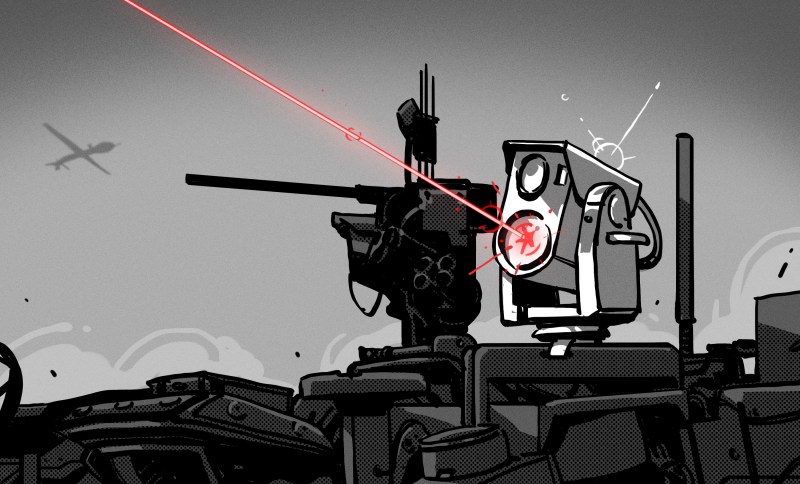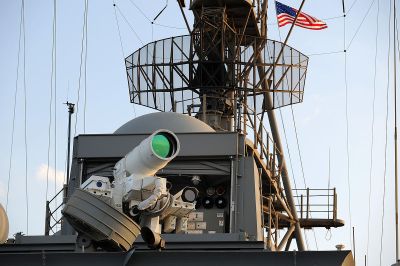
Flying drones have been a part of modern warfare for a good few decades now. Initially, most of these drones were built by traditional military contractors and were primarily used by the world’s best-funded militaries. However, in recent conflicts in Syria, Ukraine, and elsewhere have changed all that. Small commercial drones and compact militarized models have become key tools on the battlefield, for offense, defence, and reconnaissance.
With so many of these tiny craft buzzing around, militaries are scrambling for practical ways to shoot them down. Lasers might be just the ticket to do exactly that.
Why Lasers?

Shooting down drones, even the basic plasticky ones you get at Walmart, is a frustrating exercise. They’re tiny, and thus surprisingly difficult to see. They can also be difficult to detect, even if their radio emissions do help track them down.
The big problem for modern militaries, though, is that drones are often incredibly cheap. It’s simply not practical to fire a $10,000 or $50,000 missile to shoot down a drone worth a tenth of the price. Bullets are cheaper, but without guidance, they’re more difficult to get on target. The ones that miss tend to fall back to Earth, injuring people in the process. Plenty of them will miss, too, because those tiny drones are both very maneuverable, and again, very hard to track.
In many ways, lasers offer the perfect solution to this problem. The laser destroys targets by melting or incinerating drones with its powerful beam. There is no ammo involved, so many shots can be fired as long as the laser has power and doesn’t overheat. There are no shells flying through the air that will continue on to cause collateral damage, either. Of course, a laser weapon still requires a tracking system to aim at a target. However, unlike a guided missile, that expensive tracking system isn’t destroyed in an explosion when taking out a target.
Naturally, the reality of anti-drone laser technology will be nothing like what you might have seen in the movies. Star Wars-style pulses of light and pew pew sounds simply don’t reflect reality. Instead, laser weapons are more likely to be silent, barring the whirr of any cooling equipment, and many will likely rely on infrared laser technology which is invisible to the human eye.

Defence contractor Raytheon has recently announced it will invest in a new European hub to develop laser weaponry. Its primary goal will be to develop laser weapons to take out small drones, and will work on testing and fielding such hardware for military applications. These lasers would likely be intended for use on military vehicles, which can both house and carry the weapon system while providing it with the necessary power to fire.
Other countries are rushing to field their own systems, too. Russia claims to have used an anti-drone laser with 5 km range in Ukraine in May this year. Meanwhile, French company CILAS is citing success with a system that relies on radar or camera tracking, and uses a laser under 10 kW power to destroy small drones. China has developed a system using a fiber laser operating in the tens of kilowatts range, while Lockheed Martin also has a similar system in development, with an eye to defending against drone swarms. The US Army’s own MEHEL 2.0 laser testbed has also shown much success at engaging drones in testing.

It comes at a time that other laser weapon systems are also coming to fruition. The US Air Force has long pursued lasers as a potential way to defend aircraft from incoming missiles. Earlier this year, the Air Force received prototype lasers from Lockheed Martin designed for this very purpose, operating in the 60 kW range. The hope is that these high-performance lasers, mounted in pods carried by aircraft, could shoot down incoming missiles before they get close enough to do any real harm.
Unlike anti-missile lasers for fighter jets, those targeting small drones will likely be somewhat more achievable to field in the near term. They likely won’t need to be as powerful, as often they’ll be used to destroy craft made out of plastics and composites rather than advanced aerospace metal alloys. They’ll also operate at far shorter ranges. An incoming air-to-air missile moves at many times the speed of sound, so tracking and destroying it at long range is key. Small drones move at maybe a few hundred kilometers per hour at best, so it’s far more practical to deal with them at closer range.
As the tragic warfare this year has shown, even cheap, tiny drones are changing the face of the battlefield. Laser weapons seem the best way for militaries to counter this threat. All that’s left to do is develop and field them in real numbers, and the metagame of modern warfare will shift once again.
Militaries Are Rushing To Get Anti-Drone Lasers Operational
Source: Manila Flash Report
0 Comments